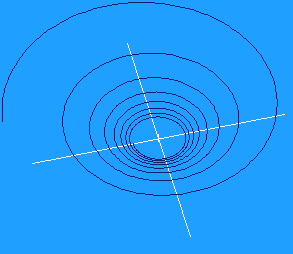
From the diagram it can be seen that, if we choose t from the interval [0, 2p] and map t to the vector
(cos t, sin t, 0) we get the unit
circle. The separate functions are:
x = cos t
y = sin t
z = 0
You can find the vector equation of any straight line through 3D space, but suppose
a mathematical model you were working on required the vector equation of a general curve
through 3D space - such as a roller coaster, or trajectory of a satellite.
A parametric curve is defined by a function. The function can be given any real number, known as
the parameter t (from a chosen segment of the real number line [a, b]) and returns a vector, the point
on the line corresponding to t. That is, it is a mapping from the segment [a,b] -> R3 3D space.
A convenient way of writing this mapping is with three normal functions, each a mapping from [a,b] ->
R:
x = f(t)
y = g(t)
z = h(t)
for each of the cartesian components of the vector returned by the earlier mapping. Here are some examples...
 |
From the diagram it can be seen that, if we choose t from the interval [0, 2p] and map t to the vector |
What curve is given by adding coefficients,
x = a cos t
y = b sin t
z = 0
for some real numbers a and b?
 |
The parameter, t, can be thought of as time, and the unit circle above is then traced out by a point which starts at (1,0,0) at t = 0 and follows the circular path counterclockwise (looking down the z axis towards -ve inf.) until it arrives back there at t = 2p. Now if the z function is changed from z = 0 to z = t, the point will rise steadily as the circular path is traversed, so creating the sprial shown. |
 |
Thinking of the curve as being traced out by a particle with the parameter t representing the time is used in Newtonian mechanics. The parametric functions above give the position of the particle at any time t, and if you have started calculus, differentiating each of the three equations (for x, y and z) with respect t, results in a new parametric curve - the positions of the points on this curve giving the velocity of the particle at any time t. Differentiating again give the acceleration at any time t.
 |
x = (cos t)(1 - sin t) |
 |
The spiral found by Archimedes, and also found in nature: |
 |
The curves of Lissajous are the set with equations: |
 |
The butterfly fly curve, discovered by Temple H. Fay, is generated by
the equations |